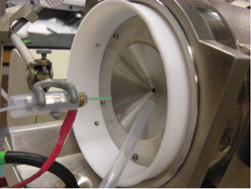Analysis of secondary organic aerosols in air using extractive electrospray ionization mass spectrometry (EESI-MS)†
Abstract

* Corresponding authors
a
Department of Chemistry and Biochemistry, Loyola Marymount University, California, Los Angeles, USA
E-mail:
lambert.doezema@lmu.edu
Fax: 310 338 2905
Tel: 310 258 2637
b
Department of Chemistry, University of California, Irvine, California, USA
E-mail:
bjfinlay@uci.edu
Fax: 949 824 2420
Tel: 949 824 7670
c
Department of Chemistry, University of Redlands, Redlands, California, USA
E-mail:
Teresa_longin@redlands.edu
Fax: 909 335-5312
Tel: 909 748 8543
d
Department of Earth System Science, University of California, Irvine, California, USA
E-mail:
Kathleen.johnson@uci.edu
Fax: 949 824 3874
Tel: 949 824 6174

 Please wait while we load your content...
Something went wrong. Try again?
Please wait while we load your content...
Something went wrong. Try again?
L. A. Doezema, T. Longin, W. Cody, V. Perraud, M. L. Dawson, M. J. Ezell, J. Greaves, K. R. Johnson and B. J. Finlayson-Pitts, RSC Adv., 2012, 2, 2930 DOI: 10.1039/C2RA00961G
To request permission to reproduce material from this article, please go to the Copyright Clearance Center request page.
If you are an author contributing to an RSC publication, you do not need to request permission provided correct acknowledgement is given.
If you are the author of this article, you do not need to request permission to reproduce figures and diagrams provided correct acknowledgement is given. If you want to reproduce the whole article in a third-party publication (excluding your thesis/dissertation for which permission is not required) please go to the Copyright Clearance Center request page.
Read more about how to correctly acknowledge RSC content.
 Fetching data from CrossRef.
Fetching data from CrossRef.
This may take some time to load.
Loading related content
